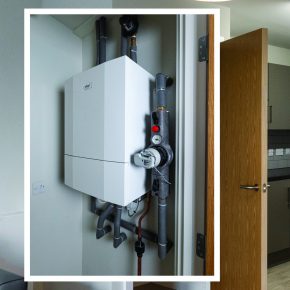
Responsible glazing systems ensure fire safety
Wrightstyle’s Managing Director, Tim Kempster
Before modern fire and building regulations, responsibility for the safety of a building and its occupants fell firmly on the shoulders of the building’s owner.
Since the Regulatory Reform (Fire Safety) Order 2005 however, responsibility has shifted across all UK jurisdictions, now requiring commercial premises to have a named ‘responsible person’ to ensure fire safety.
The ‘responsible person’ (or people, as there can be more than one) is tasked with various responsibilities and processes; including carrying out a fire risk assessment, planning for an emergency, staff training and carrying out regular fire drills.
Not only have these responsibilities been delegated to the responsible person, but as have the pressures and penalties that are attached should they fail their duty.
Safety inspectors from the fire services must be satisfied that the responsible person has discharged their responsibilities – regardless as to whether there has been an actual fire.
That’s not to say that a responsible person must be an expert in fire safety or face the wrath of government legislation; merely that he or she must appoint an person who is an expert, and assure their recommendations are understood, implemented, reviewed, and practiced.
Risk assessment
In most circumstances, problem areas are identified, containment strategies are implemented, and passive and active solutions are met to counter every conceivable fire risk.
Wrightstyle believes the responsible person must look beyond fire safety regulation to consider all possible risks against a building’s occupants, structure, resources and continuing operations in a worst case scenario situation.
A robust fire risk assessment should therefore be about more than the practicalities of regulatory compliance.
Whilst thorough risk assessments will address issues such as the storage of flammable materials, most fires start from insignificant causes, such as a lit cigarette improperly disposed of.
No matter the cause, fire is spread through three methods: convection, conduction and radiation, of which convection is the most dangerous.
Convection is when smoke from the fire becomes trapped by roof, forming a deepening layer as it spreads.
Materials such as metal can absorb heat and transmit it to other rooms by conduction, causing new fires to break out and spread in a similar pattern.
Radiation transfers heat in the air, until it too sets off secondary fires, spreading the danger away from its original location.
Responsible glazing
Modern glazing systems can provide complete protection against convection, conduction and radiation – whether as curtain walling, or internal doors or fire screens – for up to two hours, giving more than enough time for a safe evacuation.
However, responsible people should also ensure that the fire glass and its framing systems have proved compatibility.
That means insisting on comprehensive fire test certification that covers both elements because, in a fire, the glass and its frame have to function together to prevent the spread of fire, smoke or toxic gases.
If one fails, both fail, with potentially catastrophic consequences.
Wrightstyle,
Unit 2&7 Banda Trading Estate,
Nursteed Road,
Devizes,
United Kingdom,
SN10 3DY
Visit Supplier's page
Latest news

28th April 2025
Nuaire first UK ventilation manufacturer to use low carbon-emissions recycled & renewably produced steel
Nuaire has announced that its Magnelis® steel based ventilations systems are now being made from XCarb® recycled and renewably produced steel.
Posted in Air Conditioning, Articles, Building Industry News, Building Products & Structures, Building Services, Building Systems, Heating, Ventilation and Air Conditioning - HVAC, Restoration & Refurbishment, Retrofit & Renovation, Steel and Structural Frames, Sustainability & Energy Efficiency, Waste Management & Recycling
28th April 2025
Renderplas: Builders avoid costly remedial work with PVCu render beads
A pioneer of PVCu render beads, Renderplas is helping the construction industry avoid the costly remedial work associated with rusting steel designs…
Posted in Articles, Building Industry News, Building Products & Structures, Building Services, Building Systems, Facades, Posts, Render, Restoration & Refurbishment, Retrofit & Renovation, Sustainability & Energy Efficiency, Walls
28th April 2025
How Celotex’s Technical Team adds value through expert insulation support
From U-value calculations to real-world installation support, Celotex’s technical team helps construction professionals specify and install insulation with confidence…
Posted in Articles, Building Industry News, Building Products & Structures, Building Services, Insulation, Research & Materials Testing, Restoration & Refurbishment, Retrofit & Renovation, Sustainability & Energy Efficiency, Walls
28th April 2025
Ideal Heating Commercial takes extra care with the heat network at Huddersfield specialist housing development
Ideal Heating Commercial POD Heat Interface Units (HIUs) and Evomax 2 condensing boilers have been installed into Ash View Extra Care in Huddersfield.
Posted in Articles, Building Industry News, Building Products & Structures, Building Services, Case Studies, Facility Management & Building Services, Heating Systems, Controls and Management, Heating, Ventilation and Air Conditioning - HVAC, Pipes & Fittings, Plumbing, Restoration & Refurbishment, Retrofit & Renovation
 Sign up:
Sign up: